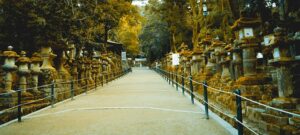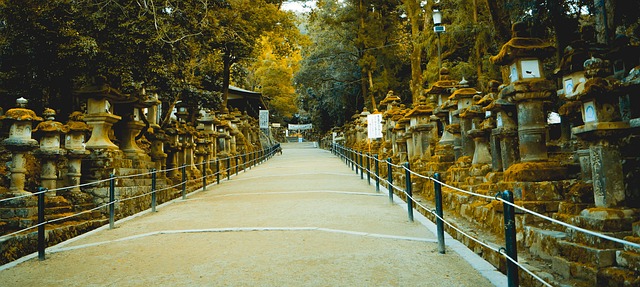学問として【日本古来のものを見なおそう】という考えが出てきました。
【国学】といわれるものです。
それが「復古神道」につながり、日本人の心である神道の見直しになっていきます。
しかし、いまでいう【右傾化】した考え方が出てきました。
それらが、後に、尊王攘夷運動や、廃仏毀釈、国家神道へとつながっていきます。
開国後の明治政府がした宗教政策は国家神道と言います。
神道というのは祖霊信仰もとにした民族宗教です。
特徴は「正典」が存在しないこと。
歴史書(古事記など)、命令書(宣命など)が聖典扱いにされています。
といっても伝説です。
仮に歴史上間違っていても
宗教的にはそこに真摯に祈り敬うことで
スピリチュアル的な真実を作り出します。
神道は古道と呼ばれ仏教理論によって形成されていました。
江戸時代に
「神武天皇から欽明天皇までは道がなく儒教到来によって神道がなった」と
儒学者が評論したことにより反発が起こり
「神道つまり惟神道こそ、日本古代から伝わる純粋な天地自然の大道であったが、
その精神は、後から伝わった仏教と儒教によって混濁させられた。
国学者の責務は、古典研究によって神道の純粋さを取り戻すことである」
国意=日本人の精神を明らかにしようとしました。
国学(≒ 蘭学反対語)において始めて古神道という概念ができました。
考え方は仏教儒学の反対です。
学問的な神道を作っていきました。
その中では
「窮屈よりも緩和、厳しさよりも優しさが勝るのが日本人本来の心なのである」
事実とは違う美しさも見られますが
「そういうものであってほしい」という
その時代の人の理念が感じられます。
日本独自の「言霊」「数霊」などが取り入れたり復興されたりもしましたが
キリスト教、浄土真宗、密教、道教を取り入れた
原理的なあたらしい宗教を作っていきます。
そこで、ずるい人たちや、行き過ぎた人たちが現れます。
天皇復権を狙う人たち。
神仏分離と神道国教化を狙う国学者。
心的膨張が世界征服への対外膨張思想家。
それはやがて
国家政策としての皇国史観となり
結果、利用したものは歴史上最大な大逆を犯し
国を滅ぼしてしまいました。
神道は
「窮屈よりも緩和、厳しさよりも優しさが勝るのが日本人本来の心なのである」
共同体を支える感覚
など本来は
美しく、心にあったものだと思い愛しています。
近年、神社は厳しい時期にあります。
明治以降の概念が社会とづれるようになってきています。
その中で、それぞれの本来の形(神仏習合や土着祭祀など)や祭祀を復興させ
新しい形を模索しています。
ここまで、様々な形で変わった神道
古きを尊び新しい形で生き残って欲しいと望んでいます。

The idea of “re-examining things from ancient Japan” emerged as a study. This is what is called “National Studies”. It led to “Restoration Shinto”, and it became a review of Shinto, which is the heart of the Japanese people. However, what is now called “right-leaning” thinking emerged. These later led to the Sonnō jōi movement, the Haibutsu kishaku, and State Shinto.
The religious policy that the Meiji government did after the opening of the country is called State Shinto. Shinto is a national religion based on ancestor worship.
The characteristic is that there is no “canon”.
Historical books (such as the Kojiki), order books (such as the Senmei) are treated as scriptures. But they are legends.
Even if it is historically wrong, religiously, it creates a spiritual truth by praying sincerely there.
Shinto was formed by Buddhist theory and was called the old way. In the Edo period, a Confucian scholar commented that “there was no way from Emperor Jinmu to Emperor Kinmei, and Shinto became due to the arrival of Confucianism”, causing a backlash.
“Shinto, in other words, was the pure way of heaven and earth that has been handed down from ancient Japan, but its spirit was muddied by Buddhism and Confucianism that came later.
The duty of a national scholar is to restore the purity of Shinto through classical research”
They tried to clarify the national intention = the spirit of the Japanese people.
In National Studies (≒ the antonym of Dutch Studies), the concept of ancient Shinto was created for the first time.
The way of thinking is the opposite of Buddhism and Confucianism. They created an academic Shinto. In it, “It is the original heart of the Japanese people that leniency wins over tightness and kindness wins over severity” You can see the beauty that is different from the fact
You can feel the ideals of the people of that time, “I want it to be that way”. Japan’s unique “Kotodama”, “Number Spirit”, etc. were incorporated and revived.
They created a new religion with principles that incorporated Christianity, Jodo Shinshu, Esoteric Buddhism, and Taoism.
Then, cunning people and people who went too far appear. People aiming for the restoration of the emperor.
National scholars aiming for Shinto and national education.
Mental expansion to the world conquest expansionist.
Eventually
It became a national view of history as a national policy As a result, the one who used it committed the biggest treason in history Destroyed the country.
Shinto is
“Leniency wins over tightness, and kindness wins over severity is the original heart of the Japanese people”
A sense of supporting the community Originally I think it was beautiful and in my heart and I love it.
In recent years, shrines are in a tough time. The concept after the Meiji era has begun to deviate from society. In it, they are reviving each original form (syncretism of Shinto and Buddhism, indigenous festivals, etc.) and festivals and exploring new forms.
So far, Shinto, which has changed in various forms I hope you will survive in a new form while respecting the old.
|
|


![[商品価格に関しましては、リンクが作成された時点と現時点で情報が変更されている場合がございます。] [商品価格に関しましては、リンクが作成された時点と現時点で情報が変更されている場合がございます。]](https://hbb.afl.rakuten.co.jp/hgb/3a46097d.1af868e2.3a46097e.efa4d578/?me_id=1395194&item_id=10000246&pc=https%3A%2F%2Fthumbnail.image.rakuten.co.jp%2F%400_mall%2Fsailstar-shop%2Fcabinet%2F08039114%2F4-1.jpg%3F_ex%3D240x240&s=240x240&t=picttext)



コメント